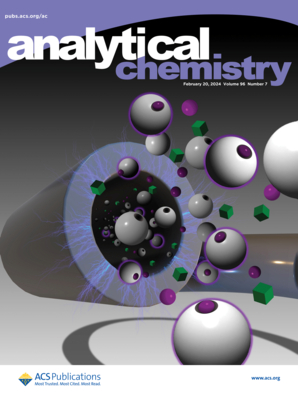Mass In Situ Hybridization Enables Mass Cytometry to Detect Telomere Length.
IF 6.7
1区 化学
Q1 CHEMISTRY, ANALYTICAL
引用次数: 0
Abstract
Single-cell resolution detection of DNA sequences is crucial for advancing our understanding of cellular differentiation and disease mechanisms. Mass cytometry has had a transformative impact on single-cell protein analysis; however, the potential of mass cytometry in genomics remains limited due to the inability to integrate DNA sequence detection. Bridging this gap is essential to expanding the capabilities of mass cytometry for comprehensive genomic and proteomic studies. In this work, we presented a novel mass in situ hybridization (MISH) strategy that enables the detection of specific DNA sequences─telomeres at single-cell resolution. At first, we synthesized a dendritic oligomer chelated with holmium (Ho), which had enough sensitivity and proper molecular size, and then conjugated it with a high-specificity telomere oligo-DNA probe containing the (AATCCC)3 sequence, a short complementary nucleic acid sequence of telomere. Finally, we successfully applied MISH to detect the telomere length via mass cytometry and imaging mass cytometry (IMC). Our method establishes the first successful strategy for telomere length detection via mass cytometry, marking a significant technological breakthrough. This innovation offers considerable potential for expanding the application of mass cytometry for the detection of specific DNA sequences.质量原位杂交使质量细胞术检测端粒长度。
DNA序列的单细胞分辨率检测对于促进我们对细胞分化和疾病机制的理解至关重要。大量细胞术对单细胞蛋白分析产生了变革性的影响;然而,由于无法整合DNA序列检测,细胞计数在基因组学中的潜力仍然有限。弥合这一差距是必不可少的,以扩大大规模细胞术的能力,全面的基因组和蛋白质组学研究。在这项工作中,我们提出了一种新的质量原位杂交(MISH)策略,可以在单细胞分辨率下检测特定的DNA序列─端粒。首先,我们合成了一种灵敏度足够、分子大小合适的与钬螯合的树突状低聚物(Ho),然后将其与含有端粒互补核酸短序列(AATCCC)3序列的高特异性端粒寡聚dna探针偶联。最后,我们成功地将MISH应用于通过质细胞术和成像质细胞术(IMC)检测端粒长度。我们的方法建立了第一个成功的通过细胞计数技术检测端粒长度的策略,标志着一个重大的技术突破。这一创新为扩大大规模细胞术检测特定DNA序列的应用提供了相当大的潜力。
本文章由计算机程序翻译,如有差异,请以英文原文为准。
求助全文
约1分钟内获得全文
求助全文
来源期刊

Analytical Chemistry
化学-分析化学
CiteScore
12.10
自引率
12.20%
发文量
1949
审稿时长
1.4 months
期刊介绍:
Analytical Chemistry, a peer-reviewed research journal, focuses on disseminating new and original knowledge across all branches of analytical chemistry. Fundamental articles may explore general principles of chemical measurement science and need not directly address existing or potential analytical methodology. They can be entirely theoretical or report experimental results. Contributions may cover various phases of analytical operations, including sampling, bioanalysis, electrochemistry, mass spectrometry, microscale and nanoscale systems, environmental analysis, separations, spectroscopy, chemical reactions and selectivity, instrumentation, imaging, surface analysis, and data processing. Papers discussing known analytical methods should present a significant, original application of the method, a notable improvement, or results on an important analyte.
 求助内容:
求助内容: 应助结果提醒方式:
应助结果提醒方式:


